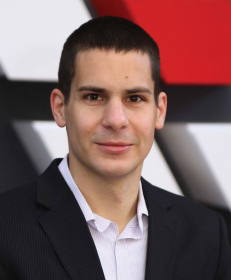Keynote Speakers

Dr. Tamás Haidegger
Óbuda University
Antal Bejczy Center for Intelligent Robotics
Title: Robots, Men, and Cybernetics
Abstract:
20 years ago, robots were stuck in the factories, working behind fences and safeguarding systems. Today, robotics is mainstream, and giant corporations from Google to Toyota and Amazon invest billions into the field. The recent rise of service robots forecasts a human–robot collaborative society, however, no one really knows what will be the rules of a safe and productive co-existence. One of the robotics community’s major tasks is to streamline development trends, work on the harmonization of technological advancement, legislations, standards and the society. The talk introduces the key areas—from self-driving cars to medical assistive devices—where the biggest leap in robotics has been observed, looking into the key enabling technologies and foreseeable consequences. Driven by the huge potential economic benefits, full automation will hit the roads within a few years, while there are numerous open technological and safety issues. In medicine, advanced robotic technology has been used to make surgeries safer, more precise or to access and manipulate tissue in micro scale, yet using only robotic technology also means that surgeons lose their manual dexterity and practice to perform classical surgeries. The current requirement of possible human intervention will not hold for long in either domain, however, anomalies do happen. As it is foreseen, robotic technology can only be superior on average measured against humans. The engineering community aims to promote cutting edge technology, to connect the developers and link them to the users of these services, while sharing the responsibility for these new technologies radically changing the way we live.
Short Biography
Tamás Haidegger received his M.Sc. degrees from the Budapest University of Technology and Economics (BME) in Electrical Engineering and Biomedical Engineering in 2006 and 2008, respectively. His Ph.D. thesis (2011) was based on a neurosurgical robot he helped developing when he was a visiting scholar at the Johns Hopkins University. His main field of research is control/teleoperation of surgical robots, image-guided therapy and supportive medical technologies. Currently, he is an adjunct professor at the Óbuda University, serving as the deputy director of the Antal Bejczy Center for Intelligent Robotic. Besides, he is a research area manager at the Austrian Center of Medical Innovation and Technology (ACMIT), working on minimally invasive surgical simulation and training, medical robotics and usability/workflow assessment through ontologies.
Tamás is an active member of various other professional organizations, including the IEEE Robotics an Automation Society, IEEE EMBC, euRobotics aisbl and MICCAI. He is a national delegate to an ISO/IEC standardization committee focusing on the safety and performance of medical robots. He has co-authored more than 130 peer reviewed papers published at various scientific meeting and conference proceedings, refereed journals and books in the field of biomedical/control engineering and computer-integrated surgery. He has been maintaining a professional blog on medical robotic technologies for over 8 years: surgrob.blogspot.com. Tamás is a passionate photographer, rock climber and an advocate of city-biking. More information of Dr. Haidegger can be found: http://irob.uni-obuda.hu/.
Dr. ir. Clara Ionescu
Ghent University
Faculty of Applied Sciences
Department of Electrical engineering, Systems and Automation
Research group on Dynamical Systems and Control (DySC)
Title:
Regulating Depth of Anesthesia: we are so different, yet so much alike
Abstract:
Depth of anesthesia (DOA) control paradigm is not new, yet it captured lately renewed interest from the research community due to the increase necessity in personalized medicine and integration of patient socio-bio-emo response in the cyber-physical world of today’s healthcare. This keynote addresses this problem from a system engineering standpoint, whereas the role of patient’s response is analysed and quantified into suitable tools for closed loop DOA control. The solution proposed is rather an “operator guide” and not a fully automatic assist device. The operator in this case is obviously the clinician who plays the role of God even for a limited time during general anesthesia operative procedures. Real life cases are presented and illustrate the necessity of an integrated approach.
Short Biography
Clara M. Ionescu was born in 1979, Cimpulung, Romania. She received the M.Sc. degree in industrial informatics and automation from ”Dunarea de Jos” University, Galati, Romania, in 2003. She obtained the Ph.D. degree at Ghent University, Gent, Belgium in 2009, on the identification of the human respiratory system by means of fractional order models. Currently, she is a professor in the same university, involved in several international projects, with both industrial and biomedical applications, in identification and control. Her main research interests are in biomedical applications, with identification and advanced control objectives in drug delivery systems, multi-drug interaction systems, diagnosis procedures for respiratory diseases and the problematic of nanorobot medicine from control engineering point of view. C. Ionescu has been the holder of a prestigious post-doctoral grant from Flanders Research Center (FWO) during 2011-2016. More information of Dr. ir. Ionescu can be found: http://users.ugent.be/~cionescu/.